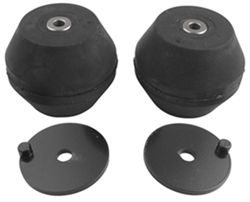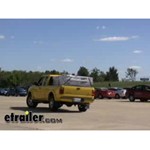
Difference in the Timbren 3,000-Lb System and the 1,000-Lb System on 2005 Ford Ranger
Question:
What is the difference between the 3000 lb and 1000 lb system? Is the 3000 lbs the weight the system handles before it starts to rely on the stock suspension? I have a 3800 lb camper I tow and Im looking to eliminate the sag in the rear end and increase my trucks performance while towing.,
asked by: Andrew R
Expert Reply:
For your 2005 Ford Ranger 4WD the Timbren Rear Suspension Enhancement System, part # TFRR0504A, has a 3,000-lb weight capacity and is for use on the rear suspension.
The Timbren Front Suspension Enhancement System, part # TFXF1004A, has a 1,000-lb weight capacity and is for the front suspension.
The Timbren system will work with the factory suspension. It does not work before the factory suspension. When mounted on the vehicle it will sit about 1 inch above the rear axle. When the vehicle is loaded, the weight will allow the hollow rubber springs to go against the axle and help support the extra weight that is put on the vehicles suspension. The entire weight of the vehicle and payload normally contacts the axle at the point under the leaf springs. By adding a secondary point of contact (just inside this point) we are reducing the stress of contact at the original point and are spreading out the load to 4 points of contact on the axle instead of 2.
The capacity rating of the suspension enhancement system is based on the nominal capacity of the rubber springs. The Timbren progressive spring rate provides superb ride quality both empty and loaded. With a light load the rubber spring has lots of travel and the ride is cushioned by the hollow rubber spring.
The Timbren system is designed to work with suspension that is in good working order. It does not increase the towing capacity of your vehicle.
I am including a link to a video review of the Timbren suspension system.

Products Referenced in This Question
Timbren Front Suspension Enhancement System
- Vehicle Suspension
- Front Axle Suspension Enhancement
- Jounce-Style Springs
- Heavy Duty
- Timbren
more information >
Product Page this Question was Asked From
Timbren Rear Suspension Enhancement System
- Vehicle Suspension
- Rear Axle Suspension Enhancement
- Jounce-Style Springs
- Standard Duty
- Timbren
more information >
Featured Help Information
Instructions
Miscellaneous Media

Continue Researching
- Video: Review and Installation of Timbren Vehicle Suspension Enhancement System
- Shop: Suspension Enhancement
- Video: SuperSprings Vehicle Suspension - Rear Axle Suspension Enhancement - SSR-113-40 Review
- Shop: SumoSprings Solo Custom Helper Springs - Rear Axle
- Shop: Timbren Rear Suspension Enhancement System
- Shop: Timbren Rear Suspension Enhancement System
- Shop: EZ Connector Magnetic 7-Way Trailer Connectors w/ Watertight Seal - Hardwire - Vehicle/Trailer End
- Shop: Universal Installation Kit for Trailer Brake Controller - 7-Way RV and 4-Way Flat - 10 Gauge Wires
- Article: Trailer Wiring Diagrams
- Q&A: Best Way to Prevent Sagging Suspension When Towing a Trailer
- Shop: Trailer Wiring
- Search Results: air bags
- Shop: Air Lift Union Tee for 1/4" Air Lines
- Article: Brake Controller 7- and 4-Way Installation Kit (ETBC7)
- Q&A: What is the Difference Between a 4-Way and 7-Way Trailer Connector
- Video: Choosing the Right Trailer Wiring
- Shop: Trailer Hitch
- Q&A: What is the Difference Between a Class II and a Class III Hitch?
- Article: Choosing the Right Suspension Kit for Your Truck and Trailer
- Video: Air Lift LoadLifter 5000 Ultimate Rear Air Helper Springs with Internal Jounce Bumpers Review
- Shop: Brake Controller
- Search Results: trailer brake controller
- Article: Wiring Trailer Lights with a 7-Way Plug (It's Easier Than You Think)
- Video: Timbren Rear Suspension Enhancement System Review RU-18-TA-00302588
- Search Results: brake controller
- Shop: Fifth Wheel Hitch
- Shop: 7- and 4-Pole Trailer Connector Socket w/ Mounting Bracket - Vehicle End
- Q&A: 7-Way Trailer Plug Adapter or Compatibility with Lance Slide-In Truck Bed Camper
- Search Results: sumosprings
- Search Results: sumosprings





























